#emu bay shale
Text
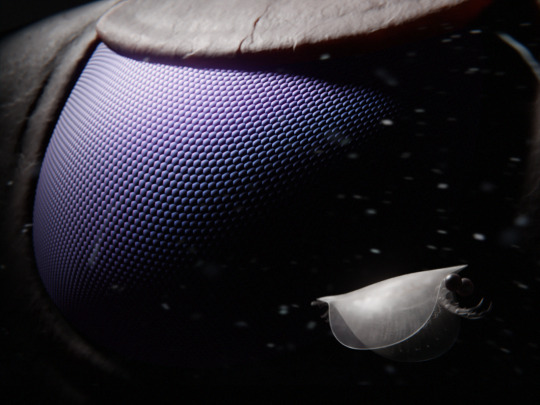
514 millions years ago in what will one day be known as the Emu Bay Shale (South Australia), a tiny Isoxys glaessneri encounters the hunter 'Anomalocaris' briggsi.
'Anomalocaris' briggsi was a large suspension-feeding radiodont related to the famous raptorial predator Anomalocaris canadensis. It is one of two radiodont species for which exceptionally detailed fossils of compound eyes are known. The eyes in this species are unsual for radiodonts in that they are not stalked, and protected by a small plate which was likely a modified version of the lateral carapace elements found in hurdiids. The eye morphology suggests that 'A.' briggsi was a mesopelagic species capable of inhabiting depths of several hundred meters, using its acute vision to detect planktonic prey (Paterson et al. 2020).
Isoxys was a cosmopolitan genus of stem-euarthropod in the Lower and Middle Cambrian, characterized by a bivalved shield covering its whole body, two large eyes, and a frontal pair of so-called 'great appendages' probably used for grasping food items. These appendages show similarity with both the frontal appendages of megacheirans and those of radiodonts like Anomalocaris, and its mix of derived and basal anatomical traits (such as biramous appendages but an unclerotized trunk) make it a crucial organism for understanding the early evolution of arthropods (Legg & Vannier 2013, Zhang et al. 2021).
I tried to recreate the feeling of this common yet lovely type of scene in sci-fi movies where a ship or station gets dwarfed by a gigantic object slowly emerging behind it from the shadows - the only difference is that the 'giant' eye here is only about 3 cm wide, though that was still huge for the time.
References and technical details about the reconstruction under the cut:
The soft parts of I. glaessneri are not known (except for the eyes). Trunk appendages are based on I. curvirostratus (Zhang et al. 2021). Great appendages are partially based on I. communis, which may be the adult form of I. glaessneri (Fu et al. 2012); unfortunately, the great appendages of I. communis are poorly preserved (García-Bellido et al. 2009), so frontal appendage morphology was complemented with the better-known I. acutangulus.
The Isoxys is depicted here with only 11 pairs of trunk limbs, instead of the usual 13+ (Zhang et al. 2021). Based on the assumption that the ancestral arthropod grew by post-hatching addition of segments (anamorphosis) (Liu et al. 2016), a reduced number of trunk limbs was judged appropriate given the small size of the specimen (ca. 6.5 mm) and the possible juvenile nature of I. 'glaessneri'.
References:
Fu, D., Zhang, X., Budd, G. E., Liu, W., & Pan, X. (2014). Ontogeny and dimorphism of Isoxys auritus (Arthropoda) from the Early Cambrian Chengjiang biota, South China. Gondwana Research, 25(3), 975–982. https://doi.org/10.1016/j.gr.2013.06.007
García-Bellido, D. C., Paterson, J. R., Edgecombe, G. D., Jago, J. B., Gehling, J. G., & Lee, M. S. Y. (2009). The bivalved arthropods Isoxys and Tuzoia with soft-part preservation from the Lower Cambrian Emu Bay Shale Lagerstätte (Kangaroo Island, Australia). Palaeontology, 52(6), 1221–1241. https://doi.org/10.1111/j.1475-4983.2009.00914.x
Legg, D. A., & Vannier, J. (2013). The affinities of the cosmopolitan arthropod Isoxys and its implications for the origin of arthropods. Lethaia, 46(4), 540–550. https://doi.org/10.1111/let.12032
Liu, Y., Melzer, R., Haug, J., Haug, C., Briggs, D., Hörnig, M., He, Y., & Hou, X. (2016). Three-dimensionally preserved minute larva of a great-appendage arthropod from the early Cambrian Chengjiang biota. Proceedings of the National Academy of Sciences, 113, 5542–5546. https://doi.org/10.1073/pnas.1522899113
Paterson, J. R., Edgecombe, G. D., & García-Bellido, D. C. (2020). Disparate compound eyes of Cambrian radiodonts reveal their developmental growth mode and diverse visual ecology. Science Advances, 6(49), eabc6721. https://doi.org/10.1126/sciadv.abc6721
Schoenemann, B., & Clarkson, E. N. k. (2011). Eyes and vision in the Chengjiang arthropod Isoxys indicating adaptation to habitat. Lethaia, 44(2), 223–230. https://doi.org/10.1111/j.1502-3931.2010.00239.x
Zhang, C., Liu, Y., Ortega-Hernández, J., Wolfe, J. M., Jin, C., Mai, H., Hou, X. G., Guo, J., & Zhai, D. (2021). Differentiated appendages in Isoxys illuminate origin of arthropodization. Research Square.
#anomalocaris#radiodont#isoxys#arthropod#eyes#compound eye#pelagic#emu bay shale#cambrian#paleozoic#paleoart#my art
485 notes
·
View notes
Text
Monday Musings
I was looking at Lagerstätten one day and realized that a vast number of them are found in Cambrian age rocks. It got me thinking: why are so many found in Cambrian rocks? Let's take a look and see what these have in common.
Emu Bay Shale, Australia

Lower Cambrian, depositional environment: restricted basins on inner shelf.
Kinzers Formation, Pennsylvannia
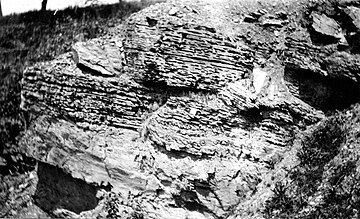
Middle Cambrian, depositional environment: deep water, outer shelf
Burgess Shale, British Columbia
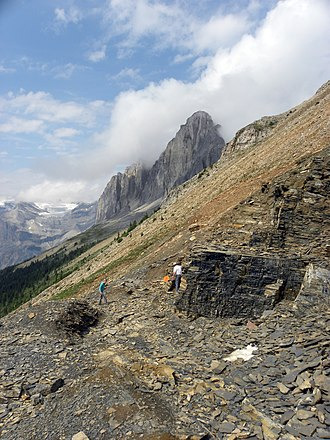
Middle Cambrian, depositional environment: below storm wave base
Spence Shale, Utah and Idaho

Middle Cambrian, depositional environment: continental shelf (both inner and outer).
Marjum Formation, Utah

Middle Cambrian, depositional environment: deep water.
Wheeler Shale, Utah

Middle Cambrian, depositional environment: below shelf where turbidites are deposited.
Weeks Formation, Utah

Middle Cambrian, depositional environment: gentle slope below the carbonate platform.
Maotianshan Shale, China
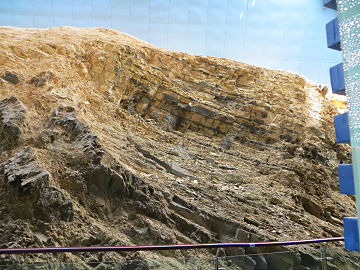
Early-Middle Cambrian, depositional environment: below turbidity currents where turbidites form.
Sirius Passet Formation, Greenland
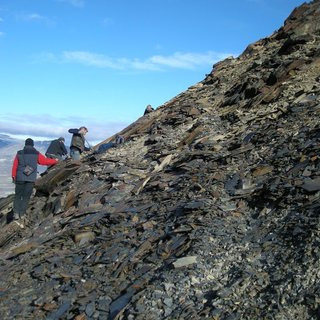
Middle Cambrian, depositional environment: slope below carbonate platform
Sinsk Formation, Russia

Early Cambrian, slope below carbonate platform
So, as we can see, most of these were formed in the Middle Cambrian below a carbonate platform or shelf also known as a reef. It would seem that if you want to be exceptionally preserved, live along the continental shelf slope and get buried in mudslides, or storm deposits.

Each of the red stars represents one of our lagerstätten. We can see that they were all within the tropics and all were on shallow continental shelves. Neat, huh?
7 notes
·
View notes
Text
Trilobite of the Day 55

Balcoracania dailyi (Pocock, 1970)
Lower Cambrian, Middle Series 2
Botoman equivalent stage
Emu Bay Shale Formation
Cape D'Estaing, Kangaroo Island, South Australia
2 cm
#posting#trans paleontologist#trilobites#paleontology#trilobite of the day#trilobite#invertebrate paleontology#fossils
12 notes
·
View notes
Text
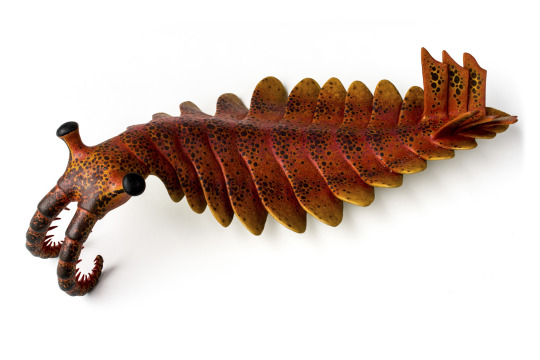



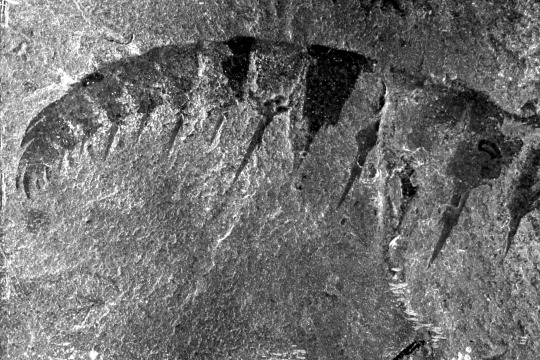

Anomalocaris
(temporal range: 540-499 mio. years ago)
[text from the Wikipedia article, see also link above]
Anomalocaris ("unlike other shrimp", or "abnormal shrimp") is an extinct genus of radiodont, an order of early-diverging stem-group arthropods.
It is best known from the type species A. canadensis, found in the Stephen Formation (particularly the Burgess Shale) of British Columbia, Canada. Other closely related fossils have been found in the older Emu Bay Shale of Australia, as well as possibly elsewhere. Originally, several fossilized parts discovered separately (the mouth, frontal appendages and trunk) were thought to be three separate creatures, a misapprehension corrected by Harry B. Whittington and Derek Briggs in a 1985 journal article.
Like other radiodonts, Anomalocaris had swimming flaps running along its body, large compound eyes, and a single pair of segmented, "frontal appendages", which in Anomalocaris were used to grasp prey. Measuring up to 56 cm (1.84 ft) long, A. canadensis is one of the largest animals of the Cambrian, and thought to be one of the earliest examples of an apex predator, though others have been found in older Cambrian lagerstätten deposits.
9 notes
·
View notes
Note
Just wanted to say that your art, especially the 3D models, are just absolutely, unironically great to me. I love how there is obviously so much care and knowledge put into it and now really need to see whether I can get access to those papers so I can read more about the cool sponges and the Emu Bay Shale and just the lime stone pebble, even if I don't understand all of it.
It might sound weird because I can't describe why, but your art is really exciting in the "science can be so much fun" way. You obviously know what you're doing in both regards and get together the Looks amazing and Communicates how interesting it is. I know I discovered this blog like yesterday but I can't stop coming back to it.
Looking forward to whatever you're going to do in the future and wish you all the best!
Thank you so much for your kind words! There really is no greater compliment to me than being told that my art conveys my love and excitement for paleontology in a way that is both informative and visually pleasing!
My illustrations are usually strongly influenced by my research work (since I'm apparently part of this masochistic breed that does want to work in academia). In fact, most of my inspiration comes when reading a paper and thinking "isn't that neat?". Paleoart is such an efficient medium for communicating paleontological ideas to all audiences (experts and general public alike), and that's the way I approach all my pieces - a kind of graphical abstract, if you will. I'm glad the message comes across!
In addition to this mostly didactic concept of paleoart, I also love making it because the reconstruction process forces to ask certain questions in order to fill visual gaps (from mundane things like coloration, to more significant elements like missing anatomy or life environment) and pushes to study many different aspects of the fossils (e.g., phylogenetic affinities, functional morphology, taphonomy, sedimentology, etc.). I always learn a lot from this exploration, and some of the questions may not have ever been seriously asked before, which can lead to some pretty interesting (and fun) reflections (does anyone have any idea what colors would be most likely for an archaeocyath?).
In any case, I'm so happy you seem to be as excited about looking at my art as I am about making it! More is certainly coming, and now that I have a bit of time I hope to be able to make some more often.
A last note regarding papers: if you (or anyone) would like to read a paper I cited but cannot access it, just send me a DM and I'll be happy to share the pdf with you if I can!
#ask#“science can be so much fun” is very much the feeling i seek to instill into all my pieces#thank you for getting this and putting it into words#saving this ask to some place where i can look at it again from time to time#because it's the sweetest thing anyone has ever told to me about my art and really understands where i'm trying to go with it
2 notes
·
View notes
Text
Cambrian lobopodians shed light on the origin of the tardigrade body plan
Published 3rd July 2023
Investigation on the origin of tardigrades by inspecting morphological comparisons between tardigrades and cambrian lobopodians and evolutionary relationships of panarthropods, lobopodians and major tardigrade lineages.
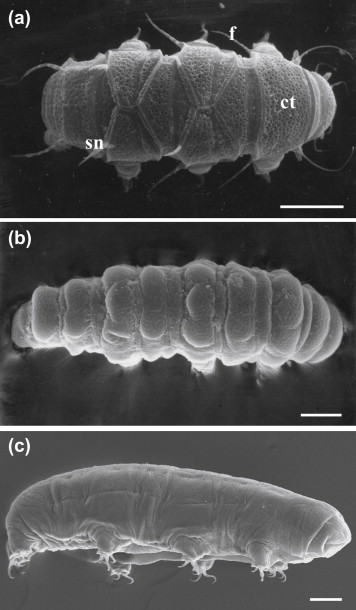
Image of phylum tartigrade, from:
(Payment required)

Various lobopodians, from:
(Note that these reconstructions may not be 100% accurate)
Analysis indicates that the ancestral tardigrades likely had a Cambrian lobopodian–like morphology and shared most recent ancestry with the luolishaniids.
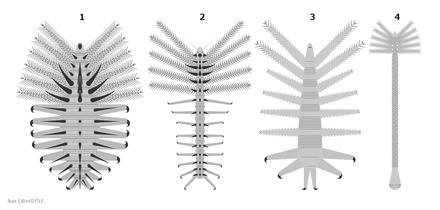
Image from above presenting Luolishaniids (Note that these reconstructions may not be 100% accurate).
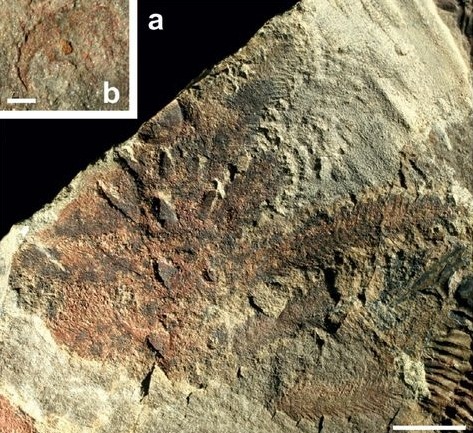
Luolishaniid lobopodian, From:
(open access)

Luolishaniid lobopodian, from:
(Payment required)
Source:
(Payment required)
2 notes
·
View notes
Link

An article published in the journal “Sciences Advances” reports a study on the eyes of Anomalocaris briggsi, a radiodon that lived about 515 million years ago, in the Cambrian period. Fossils discovered in the Emu Bay Shale, Australia, were so well preserved that they retained the their eye structure, which was found to be similar to that of their arthropod cousins and consisted of over 13,000 lenses. A team of researchers led by Dr. John Paterson of the University of New England, New South Wales, Australia, conducted a thorough examination of these fossil eyes. The conclusion is that Anomalocaris briggsi had excellent eyesight and that vision already played a crucial role in that ancient ecosystem.
1 note
·
View note
Link
For most of the nearly 3.5 billion years of documented life on Earth, creatures were simple, dominated by organisms such as bacteria, algae and fungi (SN: 10/13/18, p. 10).
Then, beginning about 541 million years ago, life quickly diversified into an array of new, complex forms. This flourishing, called the Cambrian explosion, took place within about 25 million years. Fossils from the period have been preserved in rocks at more than 50 known sites worldwide, the most famous of which is Canada’s Burgess Shale, discovered in 1909.
At five standout Cambrian sites, hundreds to thousands of different species were buried in the soft mud of long-ago seafloors. Rapid burial led to the exceptional preservation of soft-bodied animals as well as of soft tissues, such as brains, guts, eyes and skin, that typically don’t fossilize well. A newly reported site, Qingjiang in China, holds a wealth of exquisitely preserved soft-bodied animals such as jellyfish and comb jellies.
Here are some examples of the remarkable diversity of weird and wonderful Cambrian life found at these five sites:
1. Marrella
Canada’s Burgess Shale (1909)
508 million years old
Marrella fossils were some of the first found at the Burgess Shale and are the most common. At first labeled trilobites, the small, spiny sea creatures were later revealed to be a distinct type of arthropod.
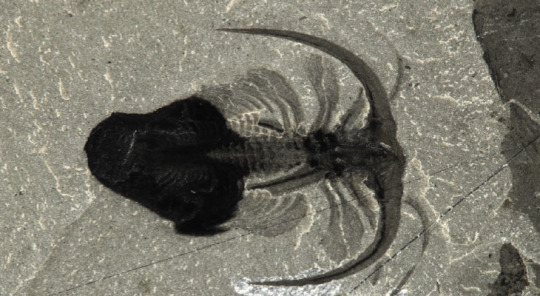
CREDIT: ROYAL ONTARIO MUSEUM
2. Fuxianhuia
China’s Chengjiang (1984)
518 million years old
Fuxianhuia fossils offer what may be the best-known view of a Cambrian brain, tucked beneath a head shield. The organ could have evolved to help the marine arthropods process detailed visual information

CREDIT: X. MA ET AL/NATURE 2012
3. Ctenophore
China’s Qingjiang (2007; reported 2019)
518 million years old
The detailed preservation of this ctenophore, or comb jelly, shows rows of combs, which are plates of fused hairlike structures called cilia. Modern comb jellies use the combs to propel themselves through the water.

CREDIT: D. FU ET AL/SCIENCE 2019
4. Anomalocaris
Australia’s Emu Bay Shale (1979)
514 million years old
Anomalocaris’ compound eyes (one shown) sported a stunning 16,000 lenses, at least. Few other arthropods, living or extinct, have had as many lenses (details shown in inset) as this marine predator.

CREDIT: COURTESY OF JOHN S. PEEL, A. BUTLER/PALAEONTOLOGY ONLINE 2015
5. Halkieria
Greenland’s Sirius Passet (1984)
515 million years old
Meet Halkieria, a scaly, sluglike creature with bivalve shells on the front and rear of its body. The animal continues to defy classification; it has been linked to early mollusks and brachiopods, also known as lamp shells.
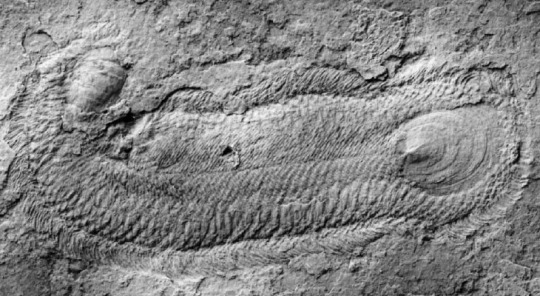
CREDIT: J.R. PATERSON ET AL/JOURNAL OF THE GEOLOGICAL SOCIETY 2016
#science#scied#sciblr#fossils#fossil#Cambrian#science visualized#sci viz#Sirius Passet#paleontology#burgess shale#chengjiang#qingjiang#emu bay shale
40 notes
·
View notes
Photo

Nesonektris aldridgei here was one of the bizarre vetulicolians, a group of Cambrian animals that lived between about 520 and 505 million years ago.
Known from the Emu Bay Shale fossil deposits in Kangaroo Island, South Australia (~514 million years ago), Nesonektris was one of the larger known vetulicolians, growing to at least 17cm long (~6.5"). Like most of its relatives it had a large streamlined forebody with a mouth opening at the front, and no obvious appendages or sensory structures. A groove down each side may have housed gill openings, and a segmented flexible tail provided propulsion for swimming.
Very little is known about the ecology of these animals. They were clearly adapted for active swimming in the water column, and may have filter-fed on plankton – but some other vetulicolians have been found preserved with their guts full of seafloor sediment, suggesting some sort of detritivorous lifestyle instead.
Their evolutionary relationships are also still uncertain, but preservation of what appears to be a notochord in Nesonektris suggests that vetulicolians may have been part of the chordate lineage, possibly close relatives of tunicates.
———
Nix Illustration | Tumblr | Pillowfort | Twitter | Patreon
#science illustration#paleontology#paleoart#palaeoblr#nesonektris#vetulicolia#deuterostome#cambrian#art#alien ravioli tadpole
181 notes
·
View notes
Link
Looking for signs of strain on trilobite legs
The team looked specifically at two exceptionally well-preserved Cambrian trilobite species. The first, Redlichia rex, comes from the Emu Bay Shale in South Australia while the second, Olenoides serratus, is from the Burgess Shale.
Redlichia rex, where 'rex' means 'king', was a big animal growing up to 25 centimetres long and was probably as terrifying a trilobite as its name implies. Its appendages show microstrain patterns along their strong-spined edge similar to those seen in the legs of horseshoe crabs and S. inexpectans. This indicates that it too probably ate hard-shelled prey in a similar grasping and cracking technique. This finding is supported by the discovery of broken trilobite remains clustered as faecal waste which suggests that it may have had cannibalistic tendencies.
The appendages of O. serratus, however, showed a different pattern. It had low microstrain values for its appendages, suggesting that this species wasn't well-adapted to crush hard prey and probably preferred to eat softer creatures, using its slender spines to pick up and manipulate flesh.

8 notes
·
View notes
Text
Período Cambriano
"
O Período Cambriano (541–485.4 milhões de anos) é o período conhecido pela explosão da vida na Terra, quando se originaram todos os principais filos de organismos multicelulares, e ocorreu a irradiação de quase todos os grupos que encontramos atualmente, em um período de tempo geologicamente curto.
Durante o Cambriano, os continentes estavam divididos em 3 porções de terra menores localizadas nos trópicos, e uma porção maior (o Gondwana) ao sul, e todos envoltos pelo oceano. As temperaturas que se elevaram a partir do final do Pré-Cambriano permaneceram estáveis durante todo o Cambriano.
//<![CDATA[ googletag.cmd.push(function() { googletag.display('dfp-arroba-meio1'); }); //]]>
Os locais onde afloram as rochas cambrianas contendo os fósseis deste período no mundo são raros, tendo como principais e mais conhecidos o Folhelho Burgess, no Canadá, o Folhelho de Maotianshan, na China, e os argilitos de Emu Bay, na Austrália.
As faunas desse período, embora primitivas, apresentavam inúmeros padrões morfológicos, uma imensa variedade de espécies, em sua maioria animais de corpo mole, e novas estratégias ecológicas, como a predação, enterrar-se profundamente no sedimento e construir túneis complexos e ramificados. Também apresentavam alguns animais esqueléticos relativamente grandes, como as trilobitas, braquiópodes, e o anomalocaris, um dos grandes predadores deste período.
//<![CDATA[ googletag.cmd.push(function() { googletag.display('dfp-arroba-meio2'); }); //]]>
Ilustração de alguns animais primitivos do Período Cambriano, incluindo o Anomalocaris (centro). Ilustração: Dotted Yeti / Shutterstock.com
Explosão Cambriana: a grande biodiversidade da fauna
As faunas fósseis que representam a explosão da vida nos mares durante o Cambriano são a Tommotiana, a de Chengjiang, e a do Folhelho Burgess.
A Fauna Tommotiana (em inglês small shelly fauna) representa o conjunto de fósseis que existiram logo no início do período Cambriano, há cerca de 570-560 milhões de anos. É caracterizada por uma fauna fóssil de pequenos animais de conchas, representando os primeiros metazoários com partes duras preservadas. Seus fósseis são encontrados em afloramentos principalmente na Rússia, entre outros locais do mundo, e abrange uma grande quantidade de pequenos fósseis de corpos duros (esqueléticos), como conchas, cones, tubos, espículas, moluscos, braquiópodes, esponjas, anelídeos, os extintos arqueociatídeos (primeiros animais formadores de recifes), entre outros.
A Fauna Chengjiang (520 milhões de anos, Cambriano Inferior) ocorre principalmente em afloramentos de Folhelhos Maotianshan, na China, conhecidos por conter todos os grupos fósseis encontrados na fauna do Folhelho Burgess, evidenciando a diversificação dos metazoários ainda no Cambriano Inferior. A fauna é caracterizada por organismos de corpo mole, bem preservados, e composta por 185 espécies de esponjas a cordados e 60 artrópodes, tais como o Anomalocáridus, Hallucigenia, Wiwaxia, Opabinia, trilobitas, entre outros.
A Fauna do Folhelho Burgess ou Burgess Shale (510 milhões de anos, Cambriano Médio) são os fósseis de animais invertebrados mais importante do mundo, pois registra um dos acontecimentos cruciais da história da vida na Terra: o resultado do processo de diversificação que ocorreu logo após o período de explosão da vida na Terra (explosão Cambriana). As rochas contendo esta fauna fóssil afloram em rochas canadenses, e contém fósseis de organismos de corpo mole preservados nos mínimos detalhes. A fauna evoluiu bastante desde a ocorrência da fauna anterior (a fauna de Chengjiang), sendo caracterizada por organismos invertebrados, sem partes resistentes fossilizáveis, e sem correspondentes com organismos da atualidade. É composta por 140 espécies distribuídas em 119 gêneros, quase um gênero por espécie, contendo artrópodes diversos (14 gêneros de trilobitas), 30 outros artrópodes (transicionais entre trilobitas e crustáceos), celenterados, medusóideos, polipóideos, anelídeos variados e equinodermos holotúróideos.
Figura 2. Vista de um afloramento do Folhelho Burguess no topo das Rock Montains canadenses, Yoho National Park. Foto: NorthStarPhotos / Shutterstock.com
Como surgiu a vida nos mares do período Cambriano
As principais condições que geraram a explosão da vida e da diversidade durante o Cambriano foram a falta de predadores nos mares, pois estes estavam originando-se e desenvolvendo-se junto a todos os outros organismos, o aparecimento de pequenos esqueletos biomineralizados (conchas e recifes), e principalmente, as mudanças geoquímicas nos mares, devido ao aumento da temperatura global e do oxigênio na Terra, liberado pelos recifes.
Impressão de uma trilobita fóssil, do Burgess Shale. Foto: inEthos Design / Shutterstock.com
Referências:
TEIXEIRA, W.; FAIRCHILD, T.; TOLEDO, M.C.M. & TAIOLI, F. (2007). Decifrando a Terra. 2ª edição, São Paulo, SP; Companhia Editora Nacional, 623p.
PRESS, F.; SIEVER, R.; GROTZINGER, J. e JORDAN, T.H. (2013). Para entender a Terra. Tradução R. Menegat (coord.), 6ª edição, Porto Alegre, RS; Bookman, 656p.
http://agencia.fapesp.br/explosao-de-vida/9893/
http://www.cprm.gov.br/publique/Redes-Institucionais/Rede-de-Bibliotecas---Rede-Ametista/Canal-Escola/Breve-Historia-da-Terra-1094.html
http://www.scotese.com/climate.htm
http://labs.icb.ufmg.br/lbem/aulas/grad/evol/especies/preposcambriano.html
Hou, X., and Bergström, J. 2003. The Chengjiang fauna – the oldest preserved animal community. Paleontological Research, v.7(1):55-70.
The post Período Cambriano appeared first on InfoEscola.
InfoEscola https://ift.tt/2ZLTrrN
Publicado primeiro em https://www.infoescola.com"
Este conteúdo apareceu primeiro em: https://ift.tt/2w0BWWY
0 notes
Photo
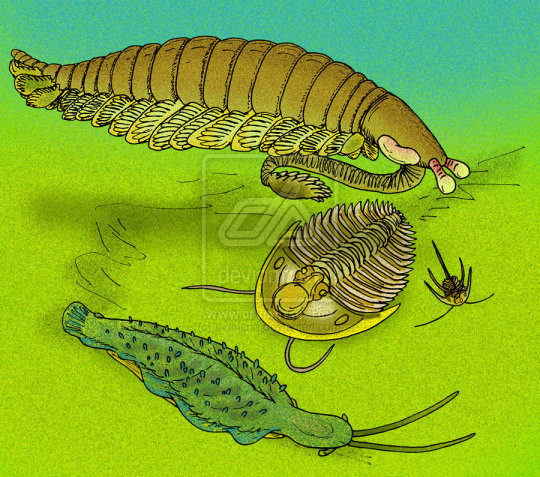
CAMBRIAN FAUNA FROM EMU BAY, AUSTRALIA
Myoscolex ateles
by =avancna
Various organisms from the Emu Bay Shale [Cambrian Series 2], which is comparable to the Burgess Shale and Chengjiang faunas.
The Emu Bay Shale is a geological formation in Emu Bay, South Australia, containing fossil beds with soft tissue preservation.
At top is the opabinid Myoscolex ateles.
Opabinia were soft-bodied arthropods of modest size; Their segmented bodies had lobes along the sides and a fan-shaped tail; they had five eyes, a mouth under the head (and facing backwards), and a proboscis that probably passed food to the mouth.
Directly below M. ateles are an adult and juvenile of the trilobite Hsuaspis bilobata.
To H. bilobata's left is the mysterious Vetustovermis plana.
Vetustovermis is a soft-bodied middle Cambrian animal, possibly a cephalopod. The single reported fossil specimen is from the South Australian Emu Bay shale.
3 notes
·
View notes
Link

An article published in "Journal of Systematic Palaeontology" reports the identification of a new species of trilobites that lived about 500 million years ago, in the Cambrian period. A team of researchers examined fossils discovered in the Emu Bay Shale, on Kangaroo Island, Australia, finding in some specimens characteristics that were different from the majority identified in the species Redlichia takooensis. Due to their size considerable for trilobites, with lengths that could reach 30 cm, and due to their predator characteristics, they decided to name the new species Redlichia rex, similarly to T.rex.
0 notes
Photo
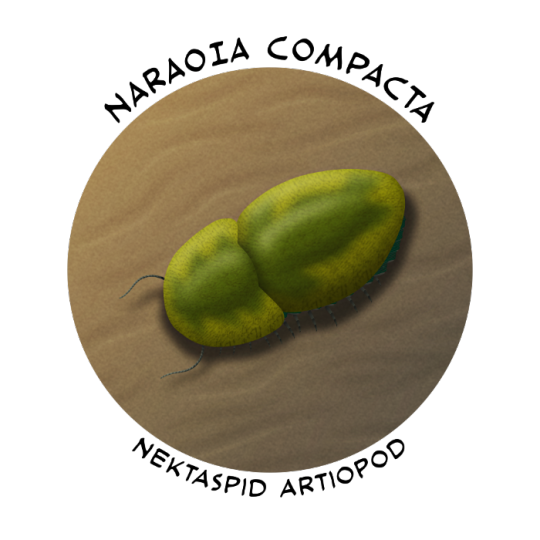
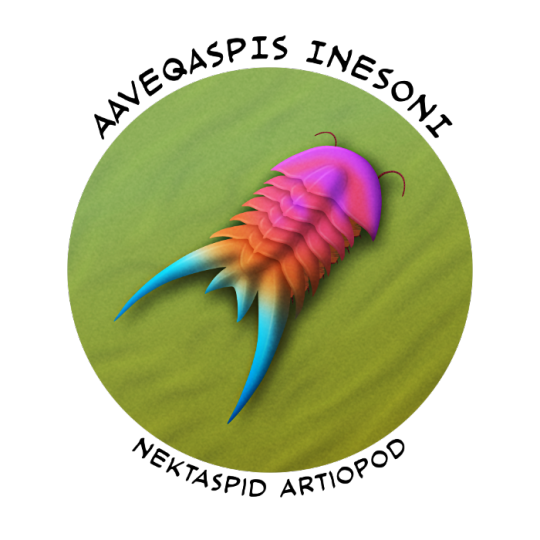
Cambrian Explosion #52: Artiopoda – Who Needs A Thorax Anyway?
The nektaspids were one of the most unique-looking groups of artiopodans, with soft-shelled unmineralized bodies, no eyes, and large head and tail shields with very few actual body segments in between – varying from 6 all the way down to none at all.
First appearing in the fossil record around 518 million years ago, only a few different species are known but they appear to have been abundant animals distributed in outer shelf waters worldwide during the Cambrian.
Their classification has traditionally been uncertain but specimens with well-preserved limbs show very trilobite-like leg anatomy, helping to place them in the artiopodans as potentially some of the closest "trilobitomorph" relatives to the actual trilobites.
———
Naraoia compacta was one of the nektaspids with no thorax segments at all, having a semicircular head shield and a large oval tail shield. Up to 4cm long (1.6"), exceptional soft-part preservation shows it also had sideways-pointing antennae and biramous limbs with large paddle-like gill-fringed flaps.
It's known from various Cambrian sites around North America, most famously the Canadian Burgess Shale deposits (~508 million years ago). Additional fossils from the similarly-aged Chinese Kaili Biota and the older Australian Emu Bay Shale (~514 million years ago) represent either even more occurrences of Naraoia compacta or a very similar closely related species in the same genus.
It was probably a bottom-dwelling animal, possibly a burrowing deposit feeder eating organic matter in seafloor mud.
One Australian Naraoia specimen shows some of the earliest direct evidence of predation in the fossil record, with a distinct bite taken out of the carapace – thought to have been inflicted by a large radiodont.
———
The evolutionary relationships of Aaveqaspis inesoni are unclear, but its general body shape suggests it may have been one of the few-segmented nektaspids.
Known from the Sirius Passet fossil deposits in Greenland (~518 million years ago), it was about 2.5cm long (1") and had a trilobite-like shape with an eyeless semicircular head shield, five thorax segments, and a tail shield bearing two huge backwards-pointing spines.
———
Nektaspids were a surprisingly long-lived group of non-trilobite artiopodans, surviving through multiple mass extinction events and lasting at least until the late Silurian about 420 million years ago. The last known member was another Naraoia species in North America, Naraoia bertiensis.
———
Nix Illustration | Tumblr | Twitter | Patreon
#science illustration#paleontology#paleoart#palaeoblr#cambrian explosion#cambrian explosion 2021#rise of the arthropods#naraoia#naraoiidae#aaveqaspis#liwiidae#nektaspida#artiopoda#euarthropoda#arthropod#panarthropoda#ecdysozoa#protostome#bilateria#eumetazoa#animalia#art#lisa frank aaveqaspis
111 notes
·
View notes
Photo
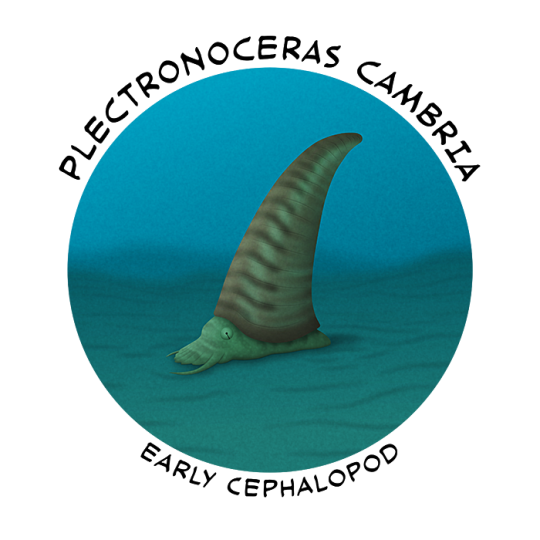
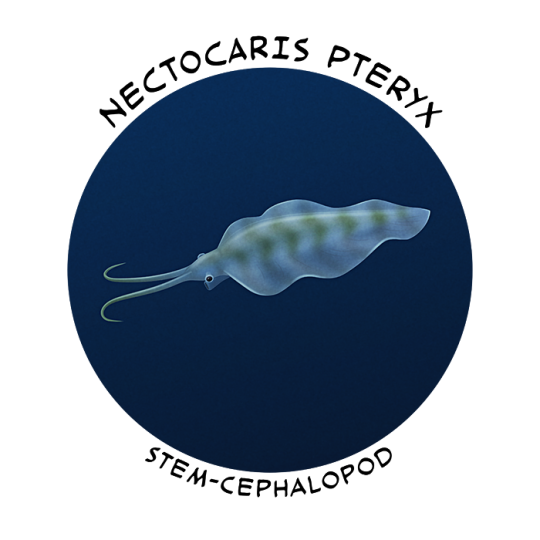
Cambrian Explosion Month #26: Phylum Mollusca – Tentacle Time
Cephalopods' highly distinctive body plan and incredible intelligence make them some of the most charismatic marine animals. Today they're mainly represented by the soft-bodied coleoids (octopuses, squid, and cuttlefish), with the modern giant squid and colossal squid being the largest living invertebrates. In comparison the shelled nautiluses seem like weird oddballs, but they're actually far more typical examples of the group than their squishier cousins – as part of the conchiferan lineage the ancestors of all modern cephalopods were also shell-bearing molluscs, and for much of their evolutionary history shelled forms like ammonites and orthoceridans were extremely abundant.
The exact evolutionary relationships of cephalopods within the conchiferan family tree aren't clear, but their closest relatives might be modern monoplacophorans and they probably descended from limpet-like "monoplacophoran-grade" ancestors in the early Cambrian. The current oldest potential cephalopod fossils come from about 522 million years ago, but the first definite cephalopods in the fossil record come from much later in the period.
Plectronoceras cambria was a tiny early nautiloid, known from the Late Cambrian of eastern China (~490-485 million years ago). Its shell was about 2cm long (0.8") and it had the characteristic features of cephalopod phragmocones – chambers, septa, and a siphuncle.
This suggests it had internal air spaces reducing the density of its shell and acting as a buoyancy control mechanism, but its shell shape also indicates it wasn't adapted for jet-powered swimming like later cephalopods. Instead it may have mostly crawled around on the sea floor, while also being able to float up vertically into the water column either to avoid predators or to access new food sources.
———
But there's a complication in the simple-seeming story of shelled ancestral cephalopods learning to float, and its name is Nectocaris pteryx.
Known from the Canadian Burgess Shale fossil deposits (~508 million years ago), the Australian Emu Bay Shale (~514 million years ago), and the Chinese Chengjiang fossil deposits (~518 million years ago), this animal had a surprisingly squid-like body with fleshy fins, two tentacles, stalked eyes, a siphon-like funnel, and no sign of a shell.
It also came in two different "size morphs", one about 3cm long (1.2") and the other about 10cm long (4"), which might represent sexual dimorphism.
For a long time it was known from only a single incomplete fossil from the Burgess Shale, with uncertain classification and strange-looking attempted reconstructions. But in 2010 many more better-preserved fossils revealed that Nectocaris seemed to be some sort of early soft-bodied cephalopod, pre-dating early nautiloids like Plectronoceras by almost 30 million years.
It's generally thought to be a member of a short-lived stem lineage that diverged early on in the groups' history, convergently losing their shells and developing a resemblance to modern coleoids – a sort of early "experiment" in coleoid-like fast active swimming, but which ultimately failed and didn't happen again until the true coleoids evolved a couple of hundred million years later.
…Except there's now yet another twist.
The recently-discovered Nectocotis rusmithi is a nectocaridid from Late Ordovician deposits in the state of New York, USA, dating to about 450 million years ago. It demonstrates that these early cephalopods survived for much longer than previously thought, and even made it through the end-Cambrian extinction event that wiped out all but one lineage of the shelled cephalopods.
And it had an internal shell – but made of a tough non-mineralized substance rather than calcium carbonate.
This brings up a couple of interesting evolutionary possibilities:
Nectocaridids might still be a weird early convergently-squid-like side branch of cephalopod evolution that internalized their shells, with Nectocaris losing the shell completely while Nectocotis retained a non-mineralized version.
Or, shells might have actually been non-mineralized (and possibly also internal) from the start in ancestral cephalopods – potentially explaining the lack of earlier Cambrian fossils. Early forms were Nectocaris-like active swimmers with a high metabolic rate, and nautiloids like Plectronoceras evolved from them during the late Cambrian when oxygen levels were dropping and such high levels of activity were less sustainable, developing mineralized external shells with energy-saving passive buoyancy and lower metabolisms.
———
Nix Illustration | Tumblr | Pillowfort | Twitter | Patreon
#science illustration#paleontology#paleoart#palaeoblr#cambrian explosion 2021#cephalopod#mollusc#conchifera#plectronoceras#nautiloid#nectocaris#lophotrochozoa#spiralia#protostome#bilateria#eumetazoa#animalia#art#convergent evolution
116 notes
·
View notes